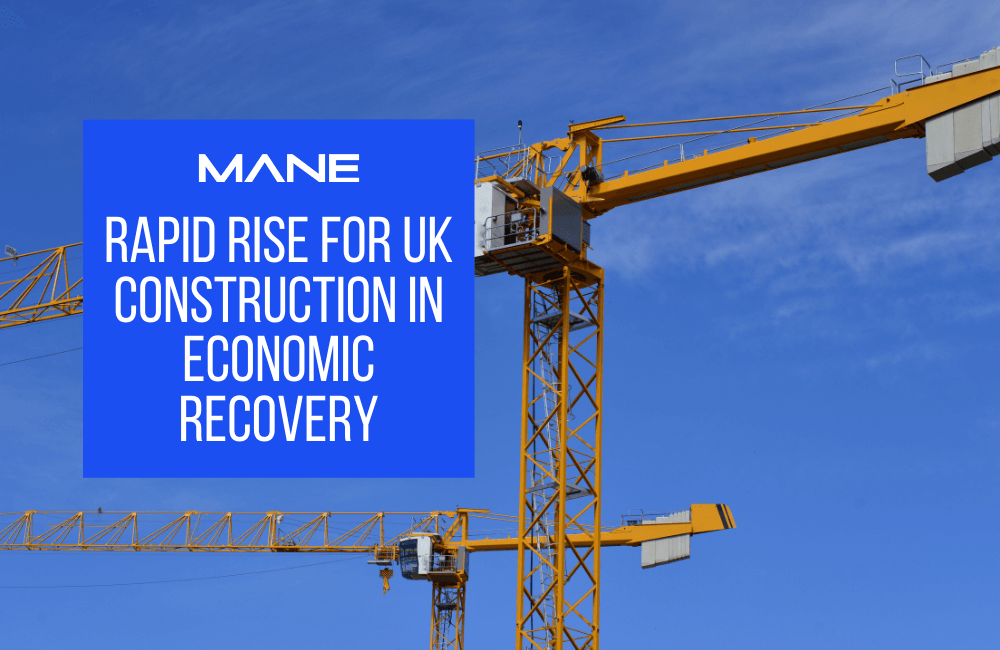Rapid rise for UK construction in economic recovery
15 Apr, 202110 minsThe British construction sector has seen its sharpest rise in activity since 2014 as signs e...

The British construction sector has seen its sharpest rise in activity since 2014 as signs emerge that our domestic economy is recovering faster than Brexit- and COVID-hit trade flows, according to new figures.
The construction sector, which produces about 6% of the UK’s total output, enjoyed increases across the board in March, with strong growth in house-building, infrastructure work and commercial projects.
Despite lockdown, the IHS Markit/CCips construction activity index was up to 61.7 in March, a major rise from 53.3 in February. Anything above 50 is considered to mean the sector is expanding, not contracting. These figures show the strongest growth in output since September 2014.
France is having a less good time of it, with a 4% rise in exports to Britain in February still leaving our cross-Channel cousins at just 84% of the monthly average from Q3 and 4 of 2020.
The UK is France’s fifth-largest export market, and French exports across the Channel fell from €2.7bn (£2.3bn) in December to €2.1bn in January thanks to a combination of lockdown and red tape.
Exports from Britain to France, however, rose by 27% to €1.5bn in February, nearly hitting the monthly average for the last half of 2020.
March also saw the UK delaying the rollout of a variety of post-Brexit import checks on EU goods by about six months, on the basis that businesses needed extra time to prepare because of the pandemic.
According to the Office for National Statistics (ONS), UK exports to the EU dropped by 41% in January and imports fell by 29%, but the impact of Brexit was difficult to quantify because of the impact of COVID on trade. France has recently tightened restrictions following a new wave of cases.
Consumers have been spending more on debit and credit cards since the relaxation of lockdown measures at the end of March, says the ONS, with card payments up to 88% of the pre-COVID average in the week ending April 1st. However, the figures are not seasonally adjusted, and end-of-month spending will have been a factor.
Overall, recent figures suggest that UK businesses have been finding ways to operate despite restrictions and that the vaccine rollout has boosted consumer confidence.
The British construction sector has seen its sharpest rise in activity since 2014 as signs emerge that our domestic economy is recovering faster than Brexit- and COVID-hit trade flows, according to new figures.
The construction sector, which produces about 6% of the UK’s total output, enjoyed increases across the board in March, with strong growth in house-building, infrastructure work and commercial projects.
Despite lockdown, the IHS Markit/CCips construction activity index was up to 61.7 in March, a major rise from 53.3 in February. Anything above 50 is considered to mean the sector is expanding, not contracting. These figures show the strongest growth in output since September 2014.
France is having a less good time of it, with a 4% rise in exports to Britain in February still leaving our cross-Channel cousins at just 84% of the monthly average from Q3 and 4 of 2020.
The UK is France’s fifth-largest export market, and French exports across the Channel fell from €2.7bn (£2.3bn) in December to €2.1bn in January thanks to a combination of lockdown and red tape.
Exports from Britain to France, however, rose by 27% to €1.5bn in February, nearly hitting the monthly average for the last half of 2020.
March also saw the UK delaying the rollout of a variety of post-Brexit import checks on EU goods by about six months, on the basis that businesses needed extra time to prepare because of the pandemic.
According to the Office for National Statistics (ONS), UK exports to the EU dropped by 41% in January and imports fell by 29%, but the impact of Brexit was difficult to quantify because of the impact of COVID on trade. France has recently tightened restrictions following a new wave of cases.
Consumers have been spending more on debit and credit cards since the relaxation of lockdown measures at the end of March, says the ONS, with card payments up to 88% of the pre-COVID average in the week ending April 1st. However, the figures are not seasonally adjusted, and end-of-month spending will have been a factor.
Overall, recent figures suggest that UK businesses have been finding ways to operate despite restrictions and that the vaccine rollout has boosted consumer confidence.


